Finland
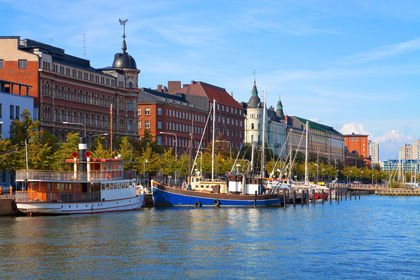
Basic Data
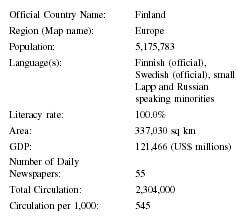
| Official Country Name: | Finland |
| Region (Map name): | Europe |
| Population: | 5,175,783 |
| Language(s): | Finnish (official), Swedish (official), small Lapp and Russian speaking minorities |
| Literacy rate: | 100.0% |
| Area: | 337,030 sq km |
| GDP: | 121,466 (US$ millions) |
| Number of Daily Newspapers: | 55 |
| Total Circulation: | 2,304,000 |
| Circulation per 1,000: | 545 |
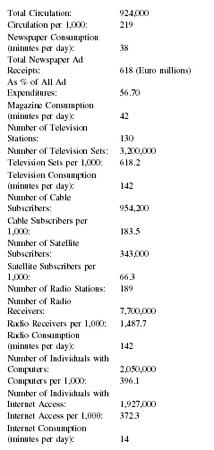
| Total Circulation: | 924,000 |
| Circulation per 1,000: | 219 |
| Newspaper Consumption (minutes per day): | 38 |
| Total Newspaper Ad Receipts: | 618 (Euro millions) |
| As % of All Ad Expenditures: | 56.70 |
| Magazine Consumption (minutes per day): | 42 |
| Number of Television Stations: | 130 |
| Number of Television Sets: | 3,200,000 |
| Television Sets per 1,000: | 618.2 |
| Television Consumption (minutes per day): | 142 |
| Number of Cable Subscribers: | 954,200 |
| Cable Subscribers per 1,000: | 183.5 |
| Number of Satellite Subscribers: | 343,000 |
| Satellite Subscribers per 1,000: | 66.3 |
| Number of Radio Stations: | 189 |
| Number of Radio Receivers: | 7,700,000 |
| Radio Receivers per 1,000: | 1,487.7 |
| Radio Consumption (minutes per day): | 142 |
| Number of Individuals with Computers: | 2,050,000 |
| Computers per 1,000: | 396.1 |
| Number of Individuals with Internet Access: | 1,927,000 |
| Internet Access per 1,000: | 372.3 |
| Internet Consumption (minutes per day): | 14 |
Background & General Characteristics
Finland has a literate and well-informed society. Ninety percent of citizens over the age of 15 spend about 40 minutes reading a daily newspaper; and on average read 10 magazines per year. The Finnish national library system, with nearly 1,000 libraries, has the most books per capita compared to other European countries. Not surprisingly, more books are borrowed per capita from their national library system than from other European systems.
Finland's population, estimated at 5,195,000 in 2001, was 48.8 percent male and 51.2 percent female in 2000. Twenty-five percent were under the age of 15, 26 percent were 20 to 39, 34 percent were 40 to 64, and 15 percent were over age 65. The country's 130,160 square miles of land is divided into 20 provinces. Twenty-five percent of the population lived in the country's largest province, Uusimaa. Finland's largest cities were Helsinki (559,718), Espoo (216,836), Tampere (197,774), Vantaa (179,856), Turku (173,686), and Oulu (123,274).
Located in northern Europe, Finland is surrounded by Norway to the north, Russia to the east, the Gulf of Finland to the south, and the Gulf of Bothnia and Sweden to the west. Prior to the twentieth century its nearly 700-year association with Sweden influenced much of Finland's culture and history and its subsequent association with Russia.
The dominant language spoken in Finland was Swedish until the 1840s. In 1835 publication of the Kalevala, a collection of Finnish myths and legends, set in motion Finnish nationalism, which helped to restore the Finnish language to prominence. By 1900 nearly 87 percent of Finns spoke Finnish, and only 13 percent spoke Swedish. One hundred years later, 92 percent were speaking Finnish, and 5.6 percent were speaking Swedish. Both languages are officially recognized by the constitution. Ethnically the language spoken reflects the distribution of the two groups. Swedish speaking persons generally lived along the south and west coasts of Finland and in the self-governing province of Aland.
Czar Alexander I of Russia conquered Finland in 1809. For the next century Finland was an autonomous duchy of Russia. After the 1917 Russian Bolshevik Revolution, Finland declared its independence. In the decade following, most newspapers were tied to political parties. By 2000, however, most were independent of political influence.
Finnish foreign policy, deeply influenced by its history of foreign dominance, is officially neutral and has helped the country to establish and maintain friendly relationships with other countries, most notably Russia. This neutrality has three basic frameworks: a special relationship with Russia; close collaboration with the other Nordic countries (Sweden, Norway, Denmark, and Iceland); and an active membership in the United Nations and the European Union.
Finland joined the United Nations in 1955, and joined the European Union in 1995. In 1999 Finland was the first Nordic country to begin using the Union's euro currency. Prior to converting to the euro, Finland's official currency was the markka (Finmark-FMK [FIM]), which was divided into one hundred pennia.
Finns adopted a new constitution that went into effect on March 1, 2000. According to the Constitution, sovereign power belongs to the citizens who are represented by 200 members of Parliament. Finland's main political parties are the Social Democratic, Finnish Centre, and the National Coalition. The minimum age to vote and to hold public office is 18.
Finns directly elect their president, while members of the Parliament elect the prime minister. The president appoints ministers who head up each of the country's 13 ministries administering governmental policies. The responsibilities of each ministry is written in the laws, however, any matters not falling within the scope of a particular ministry are handled by the prime minister's office.
With just over 2,800 newspapers published in the country in 2001, Finland ranked 18th in the world for newspaper publications and 3rd in the world, behind Japan and Norway, for newspaper circulation per 1,000 persons. Seventy-five percent of Finland's daily newspapers are delivered to subscribers each morning; the remainder is delivered by postal service. Finnish magazines also have a high subscription rate with 80 percent having regular subscribers.
Newspapers fall into four main types: national, provincial, local, and specialist. In 2000, 212 newspapers were published at least once per week, with 29 being published on a daily basis. The 55 dailies (newspapers published four or more times a week) accounted for 48 percent of the 3.8 million newspapers circulating in the year 2002. Evening newspapers published 6 days per week accounted for 20 percent of the newspaper market share. Twice weeklies accounted for 9 percent of the market share, and once weeklies accounted for 8 percent.
Of the 186 newspapers for which the Finnish Audit Bureau of Circulations reported data for 2001, 128 (69 percent) had circulations below 10,000; 19 (10 percent) had circulations from 10,000 to 25,000; 14 (7.5 percent) had circulations from 25,000 to 50,000; 11 (6 percent) had circulations from 50,000 to 100,000; 12 (6.5 percent) had circulations from 100,000 to 500,000; and 2 (1 percent) had circulations over 500,000. None had circulations over 650,000.
The top 10 daily newspapers in 2001 (which may vary depending upon the source referenced), all of which were politically independent publications, were the Helsingin Sanomat (436,000); the Ilta-Sanomat (214,372); the Aamulehti (133,779); the Turun Sanomat (115,000); the Kaleva (84,106); the Keskisuomalainen (77,475); the Savon Sanomat (67,185); the Eetla-Suomen Sanomat (62,659); the Satakunnan Kansa (56,781); and the Ilkka (55,395). Other high circulation newspapers included the

In 2002, 11 Finnish newspapers with a total circulation of 150,000 were published in Swedish. Hufvudstadsbladet, a politically independent daily newspaper published in Helsinki, was the largest Swedish language newspaper, with a circulation of 53,815 during the week and a Sunday circulation of 56,259. Finland's second largest Swedish language newspaper, the Vasabladet, was published six times a week in Vaasa with a circulation of 26,481.
After newspapers, magazines represent the second largest mass media sector in Finland. In 1999 magazine publishers with the highest circulation rates were Yhtyneet Kuvalehdet Oy; Helsinki Media Company Oy;A-Lehdet Oy;and Oy Valitut Palat —Reader's Digest Ab.
Young Finns (aged 12 to 20) are also dedicated newspaper readers. According to the 2001 Finnish Newspaper Association's national youth media usage survey, 44 percent of Finland's young people were reading a daily newspaper, with 91 percent reading a newspaper at least once a week. Twelve to twenty-year-old readers spent an average of 15 minutes a day reading newspapers. Those reading newspapers once per week were usually spending 19 minutes on Saturdays and Sundays reading them.
Newspapers have been published in Finland since 1771, when the first newspaper entitled Tidningar utgifne av et Sallskap I Abo (News Published by a Society in Turku) began circulating. Most print media produced for Finnish consumption is created by domestic enterprises. In 2002, 100 percent of Finnish newspapers, 98 percent of magazines and periodicals, and 84 percent of literature were domestically produced. In contrast, domestic television producers generated between 30 to 54 percent of Finland's national television programs.
The types of magazines read fell into the following categories: customer magazines (32.9 percent); family and general magazines (12.94 percent); women's general magazines (9.5 percent); women's special interest (6.0 percent); hobby magazines (6.0 percent); economy, technics, and trade (5.4 percent); living, building, gardening (4.3 percent); professional magazines (4.0 percent); comics (3.6 percent); motorsport, technics (3.4 percent); datatechnics, communication (2.0 percent); science and culture (2.0 percent); agricultural, forest economy, housekeeping, gardening (1.7 percent); young people's and children's magazines (1.6 percent); religion (1.7 percent); crosswords (0.9 percent); industry and building (0.1 percent).
The most popular magazine in each category was: Lusto (agriculture, forest, economy, housekeeping, gardening); Aku Ankka (comics); Elakevaen Ristkot (cross-words); Yhteishyva (customer magazines); MikroBitti (datatechnics, communication); Taloustaito Yritys (economy, technics, and trade); ET-lehti (family and general magazines); Kolramme (hobby magazines); Avotakka (living, building, gardening); Teknilkan Maalima (motor-sport, technics); Tehy (professional magazines); Kirkkoja Kaupunki(religion); Tiede (science and culture); Sotaveteraani-Krigsveteranen (social affairs and health service); Kotivinkki (women's general magazines); Hyva Terveys (women's special interest magazines); Suosikki (young people's and children's magazines).
Economic Framework
In the 1990s the European economy went through a recession that affected Finland more deeply than other countries. After 1994, however, Finland's economy, led by its telecommunications industry, recovered faster than most European countries with an average 4.8 percent gross domestic product (GDP) rate of growth. Although recovery was apparent after 1994, Finnish unemployment remains higher than the European Union (EU) average in 2002 at 9.1 percent.
Manufacturing, with 497,000 employees (21 percent), employed the largest share of Finland's labor force
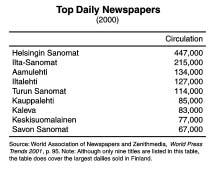
Finland exports more books, pamphlets, newspapers, and periodicals than it imports. In 1997, 1,470,000 tons of newsprint were produced; 39,000 tons were imported; 1,211,000 exported and 298,000 consumed. Consumption per 1,000 inhabitants at 57,963 kilograms, was Europe's highest in 1997.
Finland's high rate of newspaper and magazine read-ership explains the preponderance of advertising dollars spent in print versus television and radio. In 2001, 58 percent of advertising dollars was spent on newspaper ads, and 17 percent was spent on magazine ads. In contrast, only 21 percent of advertising dollars was spent on television advertising, with only 3 percent spent on radio ads.
In 2000, newspaper publishing income was primarily from advertisements (61.8 percent of revenues) followed by subscriptions (32.5 percent) and sales of single copies (5.8 percent). Costs of newspaper production were fairly evenly distributed between technical production (27 percent), editing (26 percent), administration and marketing (26 percent), and distribution (21 percent).
Although individual newspaper market shares for the 10 largest daily newspapers fluctuated from 1995 to 2001, overall circulation remained relatively stable during the same period, averaging 1.4 million. For example, the largest daily newspaper, The Helsingin Sanomat lost 7.2 percent of its readers. On the other hand, the nation's the Itlalehti increased its readership by 32.2 percent.
World Bank's analysis of who controls the media, as measured by the extent to which the state owned its country's media enterprises, indicated Finland's government does not control Finland's media. All of Finland's newspapers are privately owned, reflecting a broad range of political views. In addition, the government, through its ownership of the Finnish Broadcasting Company ( Ylesiradio Oy [YLE]) controls only 48 percent of the television market which does not exceed World Bank's standard for a monopoly, which is 75 percent of the market.
Since the 1980s Finland's largest newspaper companies changed from single product lines to multiple product lines including nearly all mass media products. By the late 1990s, provincial Finnish newspapers began exchanging editorial materials, producing common weekend supplements, and sharing printing capacities to reduce production costs.
Newspaper ownership was consolidating by 1999 with mergers and acquisitions resulting in increasing numbers of newspaper chains. By 1999, 26 newspaper chains were publishing 82 percent of Finland's daily newspapers. The four largest newspaper chains, Sanoma-WSOY Corporation, Alma Media Group, Turn Sanomat Group, and the Iikka Group controlled more than one-half of daily newspaper sales.
In 2000 Sanoma-WSOY was the second largest media company in the Nordic region (Denmark, Finland, Luxemburg, The Netherlands, Norway, and Sweden). Sanoma-WSOY resulted from the 1998 merger of Finland's leading book publishers, Werner Soderstrom Oy (WSOY) and the Sanoma Corporation, and Helsinki Media.
Finland's largest multimedia house, Sanoma-WSOY, publishes the country's two largest newspapers, the Helsingin Sanomat (455,000) and the afternoon newspaper Ilta-Sanomat (219,000). Sanoma-WSOY also publishes four smaller daily and seven nondaily newspapers. Helsingin Sanomat and Ilta-Sanomat accounted for 30 percent of the daily circulation.
Foreign ownership of Finnish mass media companies increased in the last decade. Swedish Marieberg of the Bonnier Group is the single largest owner of Alma Media, Finland's second largest multimedia house. Alma Media publishes six newspapers, four of which are dailies.
Press Laws
Citizens are guaranteed free speech, the right of assembly, and the right to publish uncensored texts or pictures. The Consumer Protection Act and the Act on Unfair Business Practice regulate mass media advertising. The consumer ombudsman and the marketing court control mass media advertising. Mass media advertisements cannot make unsubstantiated claims, nor can they be offensive to minority groups. The use of children in advertising is restricted, and the advertising of tobacco products is completely prohibited.
Finland acted early in its constitutional development to ensure the rights of the press by implementing the Act on the Freedom of the Press (Article Ten of the Constitution Act) in 1919. The Act guaranteed, "…the right of printing and publishing writing and pictorial presentations without prior interference by anyone." Section Twelve of the Finnish Constitution guarantees freedom of expression, which ensures the "…right to express, disseminate and receive information, opinions and other communications without prior prevention by anyone."
The 1919 Press Law established popular control of Finland's media by giving anyone who claimed that material printed about her or him was incorrect or offensive the right to demand correction. If the publication was found to be in error, it was obligated to grant the injured party an equal amount of type-space to be printed within two days after receiving the injured party's statement. Subsequently, in 1968, organizations of publishers and journalists established the voluntary, self-regulating Council for Mass Media (CMM).
The Council's primary purpose is to interpret "good professional practice and defend the freedom of speech and publication." CMM does not have legal authority; members voluntarily commit themselves to following ethical principles of the journalism profession. CMM has a president and nine members consisting of six media representatives (four editors and two journalists) and three members of the public. The Council president and its three public members are elected by member organizations, but they could not be members of any mass media organization.
Any private citizen or public official believing there is a breach of ethical principles in any form of mass media (newspaper, magazine, radio, or television) can lodge a complaint with the CMM. If the CMM finds through its investigation of the facts that ethics have been breached, it issues a notice that requires the party violating the principles to publish CMM's notice of findings. Complaints to the CMM are usually investigated in about three months at no charge to the person lodging the complaint.
CMM decisions are based on published guidelines that were accepted by the Union of Journalists in Finland in 1992. CMM investigated 120 public complaints in 1998. Historically CMM found in favor of the complaining party about 25 percent of the time.
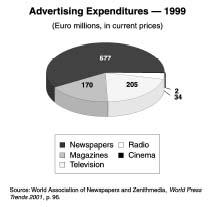
In 1951 Finland adopted an Act on the Publicity of Official Documents, and in 1999 adopted the Openness of Government Activities Act. Accordingly, documents and recordings of government are considered public, unless their publication is specifically restricted by an act.
In 1966 Finnish legislation protected the confidentiality of sources by allowing journalists to refuse to reveal the identity of sources, unless it would solve a serious crime calling for a sentence of six or more years. In 1971 protection of the confidentiality of sources was extended to television journalists.
Censorship
According to Freedom House's annual ratings of press freedom, Finland's media enjoyed relative freedom throughout the late twentieth century. While there are restrictions on mass media advertising, there is no "official" censorship in Finland.
State-Press Relations
Each of Finland's 13 governmental ministries has its own department responsible for disseminating public information and issuing press releases pertaining to its functions. Finland's government considers the media to be a "cultural industry." Media-related cultural industries are mass media (radio, television, and newspapers), cinema and video, publishing (books and periodicals), and sound recording.
Governmental policies related to radio, television, and newspapers are the responsibility of the Finnish Ministry of Transport and Communications. The Ministry of Education is responsible for cinema, video, and book publishing. The Finnish Audit Bureau of Circulations is responsible for recording the circulation levels of each Finnish newspaper.
The Ministry of Transport and Communications is responsible for assuring that "the public and the business community have safe and inexpensive transportation and communication services." The department's Mass Media Unit is responsible for administration of the mass media in Finland by handling television and radio broadcasting, mass media legislation, newspaper subsidies, postal services, and the economy and research of mass media.
According to the Ministry of Transport and Communications, governmental newspaper subsidies are paid to newspaper publishers to "guarantee freedom of speech and to conserve a diverse press." Subsidies to newspapers declined during the 1990s. In the early 1990s the Finnish government paid nearly 500 million FIM. By 2000 the amount of subsidies declined to 75 million FIM. Indirect support for the print press was discontinued by 1996. The two forms of newspaper subsidies remaining in effect in 2002 were "selective" subsidies intended to lower newspaper transport and delivery costs (30 million FIM) and "party" subsidies granted to political parties for their publications (45 million FIM). The amount of subsidies to political parties is divided among the parties depending upon their relative representation in Finland's Parliament.
Attitude toward Foreign Media
The Ministry of Foreign Affairs is responsible for providing information pertaining to Finland's government and its operations. Within the Ministry of Foreign Affairs, the Press and Culture Department handles communications with foreign media. The Ministry also makes arrangements for state and ministerial visits, and coordinates the press and cultural activities of the approximately 25 officials of Finland's Foreign Service. The Ministry of Foreign Affairs' Web site, which holds complete English translations, is the responsibility of the Ministry's Press and Culture Department.
Within the Ministry of Foreign Affairs Press and Culture Department there are four units with specific media responsibilities. The Media Unit is responsible for the International Press Center for foreign journalists and arrangements for visiting dignitaries. The Information Unit is in charge of the Ministry's external information such as press releases and media inquiries. The Cultural Unit is in charge of Finnish cultural activities and international cultural cooperation, such as cultural agreements and documents, and organizing journalists' visits related to cultural affairs. The Publications Unit handles external publications, the Press and Culture Department's library, and the maintenance of "Virtual Finland," the Foreign Ministry's Web site, the journal Kauppapolitiikka, and the annual Press Directory.
Citizens of Nordic countries do not need a work or residence permit to work or live in Finland. Citizens of European Union countries do not need to obtain a visa to enter or work in Finland but must obtain a residence permit issued by local police departments. Foreign citizens who are not members of either the Nordic or European Union countries must obtain residence and work permits in order to stay in the country longer than three months. Valid passports and a statement from the Finnish Department of Labor (which a Finnish employer must obtain for the foreign citizen) are required to secure Finnish residency and work permits. Foreigners who become eligible to live in Finland are subject to Finnish laws as well as Finnish protections. Foreign residents can choose where to live and can freely leave the country.
News Agencies
The 2002 Press Directory, published by the Finnish Ministry for Foreign Affairs, listed four news agencies. Two of the agencies, Keskustan Sanomakeskus and Up-Uutispalevlu are located in Helsinki. Startel News Agency, located in Sanomat, is an independent news agency. Svensk Press Janst, located in Helsinki is an independent Swedish language news agency.
In addition to the news agencies listed in the directory, Finland's Ministry of Foreign Affairs offers news analysis, parliamentary speeches, and articles about Finland from the foreign press. The service, Newsroom Finland, is available at the Ministry's Web site. The American Embassy also offers press and cultural affairs services at its Helsinki offices at the American Resource Center (e-mail: .)
Press Associations and Information Bureaus in the directory included the Association of European Journalists; the Association of Finnish Economic Correspondents; the Association of Finnish Foreign News Journalists; the Council for Mass Media; the Finnish Association of Magazine Editors-in-Chief; the Finnish Newspapers Association; the Finnish Periodical Publishers' Association; the Guild of Finnish Editors; the International Press Institute; the Association of Finnish Third World Development Journalists; the Political Journalists Association; Taloudellinen Tiedotustoimisto (Finnfacts); Union of Journalists in Finland; and the Western Foreign Press Club.
The Union of Journalists in Finland has about 10,000 members, 50 percent of whom are women. In addition, the Women Journalists in Finland, founded in 1946, is one of Finland's oldest journalist associations. The Women Journalists association's goals are to improve the professional skills of its members and to improve the position of female journalists in newsrooms and editorial offices. They annually select a "Torchbearer of the Year" who, through her activities, brings consciousness and debate on a current issue or problem to the public's attention.
The 2002 Press Directory listed 19 foreign news agencies and over 120 foreign correspondents. Associated Press and Reuters, along with the other foreign news agencies, had offices in Helsinki.
Broadcast Media
Commercial and public television services entered the landscape in 1957. Four domestic national television channels and six national radio networks operate in Finland. The country's first private local radio stations were established in 1985. The state-owned Finnish Broadcasting Company (YLE) broadcasts at the national level with three channels in Finnish and one in Swedish. The Companies Act and the Bookkeeping Act legislation govern YLE.
YLE's operations are based on a license issued by the Finnish Council of State (1994 Broadcasting Act). Under the legislation of the 1994 Broadcasting Act, YLE operates or supervises all television and radio broadcasting. YLE is prohibited from advertising or carrying sponsored programs on its radio and television channels; and is required to offer services in Swedish, Sami, and other minority languages. Fifty-seven percent of all television programs were domestically produced in 2001. About one-half of the foreign-produced television programs were from other European countries and about 30 percent from the United States. Foreign television programming is shown with subtitles.
YLE's largest revenues are from license fees, providing service to television companies such as YLE, MTV3, and Channel Four. The Finnish television broadcasting companies cooperatively agree to classify programs unsuitable to children under age 16. Programs considered unsuitable are broadcast after 9:00 P.M. In January 1999 YLE transferred ownership of its broadcasting distribution network to its subsidiary Digita Ltd. In November 1999 Sonera, Finland's largest telecommunications company, bought a large share in Digita Ltd.
Cable television expanded rapidly during the 1980s, and by 1995 over one-third of Finnish households had cable television. The government issues cable licenses. Cable networks are required to carry a certain proportion of domestic productions. The state also imposes advertising quotas, stating that commercials may not occupy more than 11 percent of the programming time.
The largest telecommunication company, Sonera, announced its intent to merge with another Finnish telecommunication
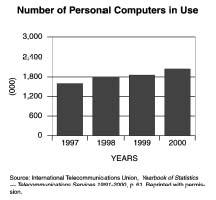
Electronic News Media
Finland's information technology knowledge has increased along with the industry itself. 60 percent of all Finns are able to use a computer. In 1999, 38 percent of the population had access to the internet, ranking second to the United States in per capita Internet connections. By 2000, nearly 90 percent of Finnish organizations employing more than 10 persons indicated they used the Internet. Further, 80 percent indicated they had their own home page.
In 2001 Finland's electronic news media was penetrating the print media's traditional market, with a 1 percent share of total national advertising expenditure going to Internet advertising. Nearly 200 Finnish journalistic publications were available on the Web, and all major media companies had their own Web sites, providing news and information in Finnish, Swedish, and English.
FinnFacts ( Taloudellinen Tiedotustoimisto ), a media service acting as a liaison between foreign media and Finnish industry, provides Internet accessible information about Finnish society. FinnFacts publishes business and industry information through its network of domestic and international contacts. It also arranges visits for members of the foreign media wanting to learn about the country's industries and innovations.
Education & Training
Finnish commitment to reading reflects on the national commitment to education and literacy. Article
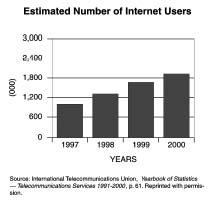
In 2001 there were 10 multidisciplinary universities ( yliopisto ). In addition, there were 6 single discipline universities, 3 art academies, and over 20 polytechnic schools ( ammattikorkeakoulut ). The categories of higher education degrees offered by Finland's universities are the Bachelors, the Masters, and two graduate degrees, the licentiate and the doctorate.
Finland was the first of its Nordic cousins to offer a degree program in journalism in 1925; The University of Helsinki followed in 1965 and Jyvaskyla in 1985. In 1960 The University of Tampere became the leading Finnish university for journalism studies. Between 1960 and 1990 the University graduated 400 professional journalists (with B.A. degrees) and 900 masters degree students majoring or minoring in the field. Since 1993 Tampere's program averages 35 to 40 M.A. graduates. Annual new enrollment in journalism programs averages 80 at Tampere, 20 at Helsinki, and 20 at Jyvaskyla.
Journalism-related degree programs are available at the University of Helsinki, the University of Tampere, the University of Jyvaskyla, and the University of Arts and Design Helsinki. The University of Helsinki's Department of Communication, founded in 1978, accepts 35 students each year. Its journalism program includes courses in general communication theory, study of mass communication, organizational and interpersonal communication, communication policies and technologies, and the media. The University of Tampere's Journalism and Mass Communication program includes courses in theories of communication, media economy and policy, media analysis and criticism, media research issues, Finnish media and communication systems, and current issues in communication and information sciences in Finland. The University of Jyvaskyla's Department of Communications offers courses in journalism, speech, organizational communication, and public relations. The University of Art and Design Helsinki offers degree programs in Film and TV studies, and in Journalism Photography.
Most degree programs require 140 to 160 credits consisting of basic studies, professional studies, elective studies, job training, and a written thesis. Finland's degree students learn the fundamentals of the field in which they major, its importance in the work world, in Finnish society, and internationally. Students are also required to take language studies in both their native language and at least two more foreign languages.
Enrollment at Finland's universities in 2001 was 162,800. Eighty-five percent of Finnish university students were undergraduates. About 21,000 (15 percent) were postgraduate students. Entry was highly competitive with only 43 percent (28,400) of the 65,400 applicants being accepted. In the "open university" system 83,200 students were enrolled, and another 106,700 Finns participated in continuing education.
In addition to the professionally recognized journalism degree programs, the Union of Journalists, as well as media employers, offer journalism-related courses through the university centers. For example, Helsingin Sanomat, Finland's multimedia giant, offers in-house education programs in journalism, and the Finnish Broadcasting Company (YLE) has its own Radio and Television Institute for its staff. Media courses are also available at the civic colleges.
Journalism and media related centers providing research, training, and publicity related to journalism operate at the University of Tampere at the Journalism Research Centre. A regional center, The Nordic Centre for Media and Communication Research, whose focus includes Denmark, Finland, Iceland, Norway, and Sweden, headquarters in Sweden with a branch at the University of Tampere.
Non-Finnish students can obtain residency permits in order to study in the country, provided they demonstrate they have enough funds to support themselves. During the period in which they are studying at Finnish universities, foreign students are able to work without a permit. The Centre for International Mobility (CIMO), a unit of the Finnish Ministry of Education located in Helsinki, promotes international student exchange programs.
Summary
Finland's overall daily newspaper circulation remains relatively stable at about 1.4 million each year, indicating market saturation has occurred. Finnish newspaper publishers have responded to the market saturation by merging companies and by reducing publication costs. Mass media consolidation leading to the creation of multimedia enterprises picked up steam in the late 1990s with more newspapers operating as chains and increased sharing of editorials, weekend supplements, and printing capacities among the provincial newspapers.
Advertisers wishing to reach consumers are likely to continue having success with newspapers, since 9 out of 10 Finnish adults read a daily newspaper. However, it is likely that in a society as well-educated as Finland that the ease of Internet access and its continually fresh content will eventually cut into not only the traditional newspaper subscriber market but also the traditional advertising market.
Since Finland liberalized foreign investment restrictions in 1993 and joined the European Union in 1995, internationalization of Finnish mass media companies has increased. Initially the increase resulted in more Finnish media companies buying companies outside the country. However, because of their closeness to and expertise in the Baltic States and the independent states of the former Soviet Union, Finns are hoping to attract more foreign investors by serving as a gateway to those countries. Finland's promotion of foreign investments will undoubtedly result in continued consolidation of its own mass media ownership under the control of fewer and fewer multimedia giants—especially those wishing to tap into the potential markets of the former Soviet Union.
Significant Dates
- 1999: Finland is first Nordic country to adopt the euro (European Union currency).
- 1999: Finland's state-owned television broadcaster, The Finnish Broadcasting Company (YLE), transferred ownership of its distribution network to its subsidiary Digita Ltd. Later in the year, Sonera purchased a large share of Digita.
- March 2000: Finns adopt a new constitution.
- 2002: Sonera and Telia announced their intent to merge, which would make them the leading telecommunications group in the Nordic and Baltic regions.
Bibliography
Central Intelligence Agency (CIA). The World Factbook 2002. Available from www.cia.gov .
Finland Ministry for Foreign Affairs, Department for Press and Culture. Finland Press Directory: 2002. Helsinki: Edita Publishing, 2002.
Finland Ministry of Education. "Education, Training and Research in the Information Society: A National Strategy, 2000-2004." Helsinki: 1999.
Finland Ministry of Finance, Statistics Finland. "Mass communication as employer 1980-1998)." Updated 25 September 2001.
——."Mass media turnover 1980-2000." 17 June 2002.
——."Population by age and sex 1950-2000." 17 June 2002.
——."Share of domestic production in different sectors of mass communication." 17 June 2002.
Finnish Audit Bureau of Circulations. "Circulations of Periodicals 2001." 18 June 2002.
——. "Newspapers 1990-2001." 28 May 2002.
Finnish Newspapers Association. "Facts about the Finnish Press." 2001.
Nordicom. "Media Trends 2001 in Denmark, Finland, Ireland, Norway, Sweden: Statistics and Analysis." Sweden: 2002.
Solsten, Eric, and Meditz, Sandra W., eds. Finland: A Country Study. Washington, D.C.: Federal Research Division, U.S. Library of Congress, 1990.
Stockmann, Doris, Niklas Bengtsson, and Yrjo Repo. "The Book Trade in Finland." 1999.
Sussman, Leonard R., and Karen Deutsch Karlekar, eds. "The Annual Survey of Press Freedom 2002." New York: Freedom House, 2002.
Union of Journalists in Finland. "Guidelines For Good Journalistic Practice." Adopted by the Union of Journalists in Finland in November 1991, entered into force on January 1, 1992.
U.S. Census Bureau. International Database. Washington, D.C., 2000.
U.S. Department of State. "Background Note: Finland." Bureau of European and Eurasian Affairs: Washington, D.C., June 1999.
——. "FY 2001 Country Commercial Guide." U.S. Embassy Helsinki: Bureau of Economic and Business, July 2000.
U.S. Department of State, Bureau of Economic and Business Affairs. "2001 Country Reports on Economic Policy and Trade Practices." Washington, D.C., February 2002.
Sandra J. Callaghan